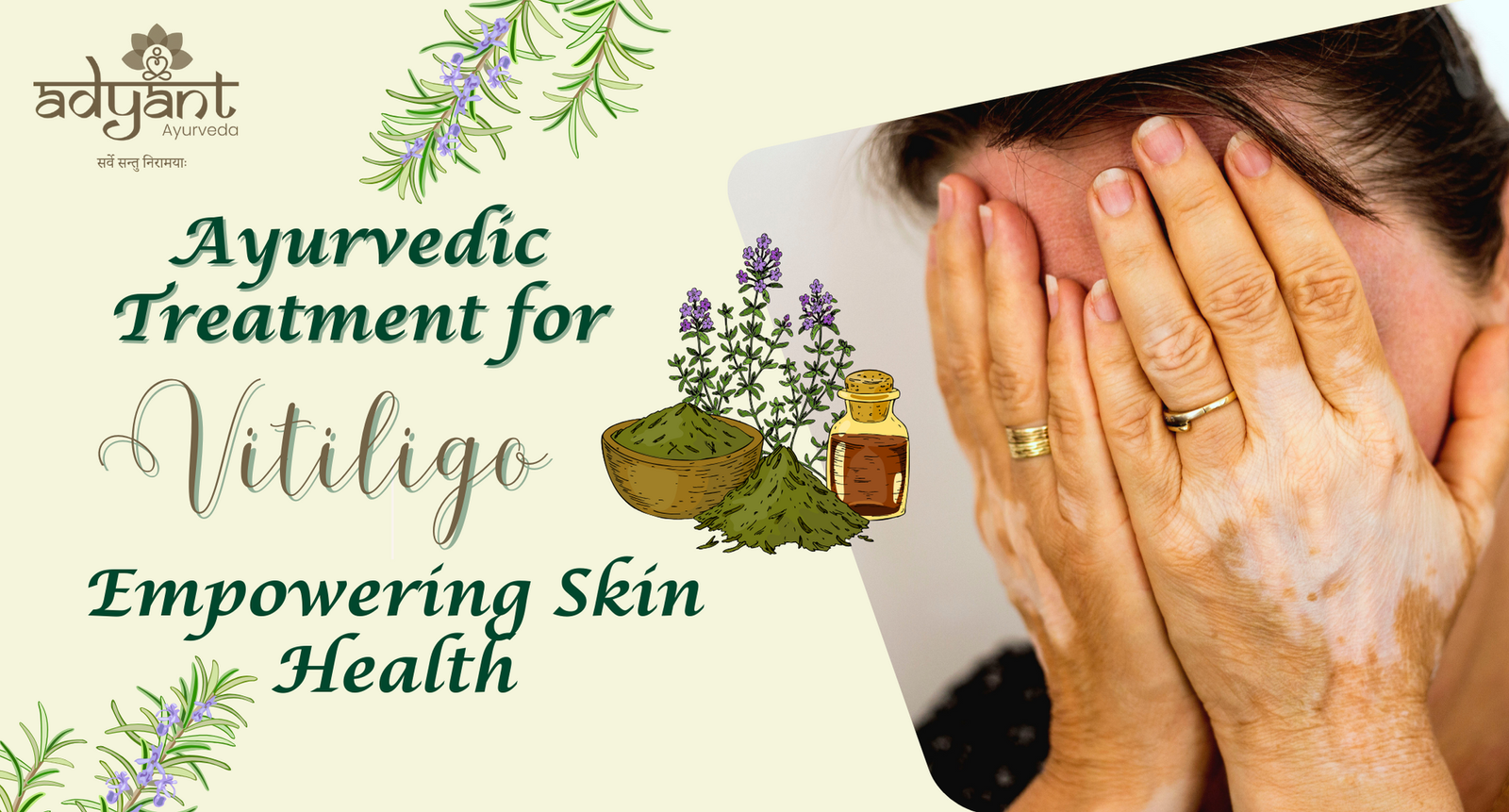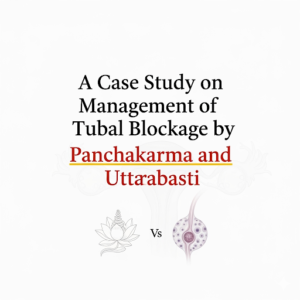Vitiligo, also known as Leucoderma, is a chronic skin condition where white patches develop due to loss of melanin (the pigment responsible for skin color). While modern medicine provides symptomatic relief, Ayurveda offers a holistic, root-cause approach — focusing on detoxification, dosha balance, immune modulation, and skin rejuvenation.
Table of Contents
Toggle📌 What is Vitiligo / Leucoderma?
Vitiligo (Leucoderma) is an autoimmune skin disorder where melanocytes (pigment-producing cells) are destroyed or become inactive. This leads to depigmented white patches that can affect any part of the body, including the skin, scalp, mucous membranes, and eyes.
🔎 Types of Vitiligo
| Type | Description |
|---|---|
| Segmental Vitiligo | Affects one area or segment of the body; early onset |
| Non-segmental (Generalized) | Most common: symmetrical patches on both sides |
| Focal Vitiligo | Limited to a small area |
| Mucosal Vitiligo | Affects mucous membranes (mouth/genitals) |
| Universal Vitiligo | Very rare; affects almost the entire body |
| Trichrome Vitiligo | Three shades: normal skin, lighter, and white |
| Confetti Vitiligo | Tiny white specks grouped together |
🧬 Causes of Vitiligo / Leucoderma
Autoimmune disorder
Genetic predisposition
Oxidative stress
Emotional stress or trauma
Hormonal imbalance
Excessive sunburn or chemical exposure
🪔 Ayurvedic Understanding of Vitiligo (Shwitra)
In Ayurveda, vitiligo is called Shwitra or Kilasa, categorized under Kustha Roga (skin diseases). It results primarily from Pitta imbalance along with the involvement of Rakta Dhatu and Ama (toxins).
🔄 Pathogenesis (Samprapti):
Imbalance in Pitta → Impaired skin metabolism
Ama accumulation → Blocks skin channels (Srotas)
Mental stress → Aggravates doshas
Vitiated Rakta (blood) → Affects melanocyte function
🌿 Ayurvedic Herbs for Vitiligo / Leucoderma
These herbs aid in melanin regeneration, blood purification, and immune balance.
🧾 Herbal Table
| Botanical Name | Ayurvedic Name | Key Actions | Benefit in Vitiligo | Usage |
|---|---|---|---|---|
| Psoralea corylifolia | Bakuchi | Stimulates melanocytes | Re-pigmentation | Oil, paste (with sun exposure) |
| Rubia cordifolia | Manjistha | Blood purifier | Detoxifies Rakta | Powder, decoction |
| Azadirachta indica | Neem | Antibacterial | Reduces inflammation | Juice, capsules, oil |
| Tinospora cordifolia | Guduchi | Immunomodulator | Boosts immunity | Decoction, capsule |
| Emblica officinalis | Amalaki | Antioxidant | Repairs skin | Powder, juice |
| Curcuma longa | Haridra | Anti-inflammatory | Soothes skin | Paste, with milk |
| Acacia catechu | Khadir | Detoxifier | Purifies blood | Decoction |
| Picrorhiza kurroa | Katuki | Liver detox | Supports skin detox | Capsules, powder |
| Ficus religiosa | Ashwattha | Skin tonic | Aids pigmentation | Bark powder paste |
| Wrightia tinctoria | Indrajao | Anti-leukoderma | Re-pigmentation | Herbal oil |
| Cassia tora | Chakramarda | Detoxifier | Stimulates melanin | Seed paste |
| Holarrhena antidysenterica | Kutaja | Gut-skin balance | Manages toxins | Decoction, tablets |
| Piper longum | Pippali | Absorption enhancer | Enhances herbal efficacy | Powder with honey |
🛠️ Ayurvedic Therapies for Vitiligo / Leucoderma
✳️ Shodhana Chikitsa (Detoxification)
Virechana – Pitta-purging laxative treatment
Basti – Enema therapy for detox and dosha balance
Raktamokshana – Bloodletting (for localized vitiligo)
Swedana – Herbal steam therapy to open skin channels
✳️ Shamana Chikitsa (Pacification)
Herbal pastes and oils (Bakuchi, Manjistha)
Oral medications: Khadirarishta, Guduchi Ghanvati, Arogyavardhini Vati
Rasayana therapy for rejuvenation
🍽️ Diet & Lifestyle for Vitiligo Management
✅ Pitta-Pacifying Diet
Fruits: Pomegranate, grapes, papaya
Grains: Barley, basmati rice
Veggies: Pumpkin, snake gourd, leafy greens
Oils: Ghee, coconut oil
Herbs: Coriander, fennel
❌ Avoid:
Sour and fermented foods
Seafood and milk together
Stress, alcohol, and caffeine
Excessive sun exposure
Non-vegetarian food
🧘♀️ Yoga & Mind-Body Support
Asanas: Sarvangasana, Viparita Karani, Halasana
Pranayama: Anulom Vilom, Bhramari
Meditation & Yoga Nidra: To reduce oxidative stress
🔬 Scientific Studies & Modern Research
Psoralea corylifolia (Bakuchi) shown to increase melanogenesis under UV light – NIH Study
Manjistha & Neem have proven antioxidant and anti-inflammatory effects – Research Article
Guduchi’s immunomodulatory effect in autoimmune conditions – PubMed
Combination of Ayurveda and phototherapy in vitiligo
👨⚕️ Case Studies (Short Summaries)
Case 1:
Patient: 26-year-old female
Condition: Focal vitiligo on fingers
Treatment: Virechana, Bakuchi oil, Manjistha decoction
Result: 60% re-pigmentation in 3 months
Case 2:
Patient: 34-year-old male
Condition: Non-segmental vitiligo, under stress
Treatment: Guduchi, Katuki, Raktamokshana + Yoga
Result: Visible improvement in skin tone and mood after 5 months
Case 3:
Patient: 12-year-old boy
Condition: Mucosal vitiligo
Treatment: Kutaja decoction, Pippali, internal rasayana
Result: Slowed spread of patches and initiation of re-pigmentation
🌼 Final Thoughts
Leucoderma or Vitiligo is more than a skin condition — it impacts self-esteem and emotional well-being. Ayurveda offers hope, addressing both the root cause and symptoms through natural, time-tested methods.
👩⚕️ Seeking Ayurvedic Treatment for Vitiligo / Leucoderma?
✨ Adyant Ayurveda specializes in vitiligo and skin care through personalized Panchakarma therapies and herbal protocols.
📍Visit our centers in Jayanagar, Indiranagar, Kalyan Nagar, or Rajarajeshwari Nagar – Bangalore
📞 Call us at 9972541009 to consult our Ayurvedic skin experts today!
Read Other Related Blogs
Ayurvedic Treatment for Psoriasis
Ayurvedic Treatment for Eczema
Ayurvedic Skin Care Tips for Every Age
Ayurvedic Skin Care Treatment: DIY Home Remedies, Therapies & Formulations
❓ Frequently Asked Questions (FAQs)
🔹 Is vitiligo curable in Ayurveda?
Vitiligo can be managed effectively in Ayurveda. While not every case is reversible, early-stage vitiligo responds well, especially with Panchakarma and herbal care.
🔹 How long does Ayurvedic treatment take?
Visible results may take 2–6 months, depending on the extent, chronicity, and body response.
🔹 Can diet affect vitiligo?
Yes. Improper food combinations (like milk with fish) and a Pitta-aggravating diet can trigger or worsen vitiligo.
🔹 Is Bakuchi oil safe?
Yes, when used under Ayurvedic guidance. Always do a patch test before topical application.






